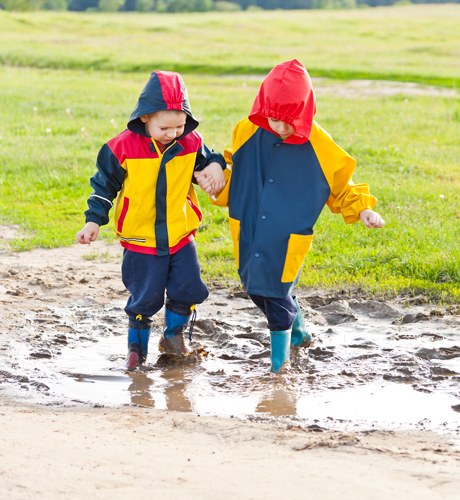Spring time often means April showers and muddy trails, yards, and playgrounds. Sometimes the prospect of trekking through mud becomes a deterrent to outdoor time for children and adults. But some people find mud to be almost magical and puddles to be powerful. Most children get excited when given the opportunity to enjoy mud. In fact, the World Forum Foundation: Nature Action Collaborative for Children designates June 29th as International Mud Day.

"[Children] thrive when we are enthusiastic too, taking pleasure in being outdoors together with them. Young children have a particular way of interacting with their world and of learning about and from it. They interact and learn through movement and doing, involving their whole body and using it to find out and to express. They take in information through all their senses, with less emphasis on talk than we do as adults. Their brains are like sponges noticing things that adults miss or filter out." - Jan White, author of Playing and Learning Outdoors
Why mess with mud?
Children long to be "exuberant and messy." (White) Mud play gives them that opportunity. This sensory-rich fun also builds their immune systems as their skin is exposed to beneficial bacteria in the soil. It's fun to get dirty. It is also important to teach children two important rules.
- No consumption of the mud
- Always wash hands well after playing in mud
In rural communities, many homes have a "mud room" which allows people to take off the messiest layer of clothes and wash off the bulk of the mud before coming into the living area. Early care programs may replicate that idea by having a bucket of warm water outside or an outdoor tap and dish pan that can serve as the first wash station with additional clean-up inside.
Stay close to children when they are near water. Even a few inches of water in an open container can be a possible hazard. Use "touch supervision" - this means to have an adult be within an arm's length of each of the children.
What children may not know is while they are having a wonderful time playing in the mud, they are:
- developing large and small muscles,
- improving balance and self-control,
- refining hand-eye coordination,
- gaining an awareness of material properties and how they change, and
- releasing stress.
Traversing muddy areas on a walk challenges motor skills and provides adventure! "Children are seriously disadvantaged if they do not learn how to approach and manage physical and emotional risk. They can become either timid or reckless, or be unable to cope with consequences." (White) Mud walks give them an opportunity to experience and manage small risks.
A mud kitchen
If opportunities exist for playing with mud in addition to walking through mud, adults may want to set up a mud kitchen. This role-playing space has all the benefits of a walk but also exercises important 21st century STEM skills like imagination, curiosity, and experimentation. Mud kitchens can be stocked with pans, utensils, serving dishes, water, and natural materials to "cook" with. Children can create with soil, sand, grass clippings, pine needles, mulch, anything they find in their nature pantry! Digging, scooping, stirring, and carrying tools support this play.
Dress for mud!
With the right apparel, adults can warm up to the idea that mud can be fun too. "Suitable clothing liberates children's play." (White) Having a good pair of boots and sets of spare clean, dry clothes available makes an outdoor, muddy walk more likely, and more FUN! Adults are less likely to say, "Walk around that mud," or "Be careful, don't get your sneakers in the mud," if children are dressed for the muddy landscape. When exploring, children and adults should wear mud-worthy boots--calf or knee-high rubber boots with good treads. In warmer weather aqua socks or some other water shoe also works fairly well on wet terrain because they are easy to hose off after the group has returned from an outdoor walk. Once muddy play is finished, children can change out of muddy clothes and don fresh, clean, dry clothes for the remainder of the day. Older children can help rinse clothes or hang clothes on a rope or fence to dry.
For those who want to embrace the mud adventure, more resources and encouragement can be found at Muddyfaces.
References:
-
White, Jan. 2015. "Making a Mud Kitchen." World Forum Foundation.
-
Wildish, Gillian. 2014. "Benefit Risk Assessment: Mud Kitchen and Digging Patch." muddyfaces.co.uk.
-
World Forum Foundation. 2015. "World Forum International Mud Day." worldforumfoundation.org.

